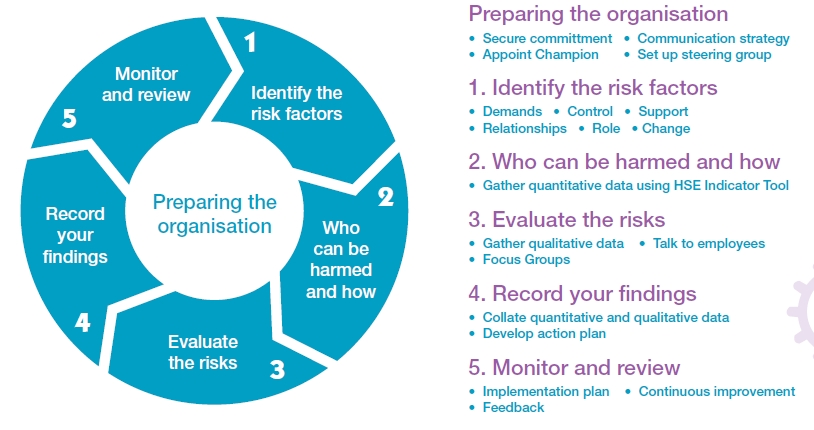Health and safety legislation requires employers to assess the level of risk from hazards in the workplace and to take all reasonably practicable measures to prevent or sufficiently reduce that risk. The purpose of a risk assessment is to find out whether existing control measures prevent harm or if more should be done.
The duty to conduct an assessment includes assessment of the risks associated with mental health at work.
The Health and Safety at Work (Northern Ireland) Order 1978 is the primary piece of legislation covering health and safety at work and Article 4 places a duty of care on employers to protect the health of employees. A specific duty to conduct a suitable and sufficient risk assessment is contained within regulation 3 of the Management of Health and Safety at Work Regulations (NI) 2000. This duty includes assessment of the risks to mental health.
The Health and Safety Executive (HSE) Management Standards are a set of conditions that if managed correctly in organisations, can reflect high levels of health and wellbeing an organisational performance. The Management Standards approach is an organisational, preventative process for managing the risks to employees from work-related stress. It is considered to be the best practice approach to managing work-related stress and is a free-to-use toolkit that helps employers prepare for and conduct an appropriate risk assessment. Whilst alternative methods of managing work-related stress may be used, it is generally accepted that implementation of the Management Standards will constitute a suitable and sufficient assessment of the risks.
Implementation of the Management Standards can be summarised into 5 keys steps. Before embarking upon the process it is important that the organisation is suitably prepared. Important aspects of preparing the organisation include securing commitment from senior managers, appointing a champion, setting up a steering group and developing a communication strategy to highlight to staff how the process unfolds.
The five steps of implementing the management standards are illustrated in the management wheel below.

The risk factors are the 6 key areas of work design considered to be the primary sources of work-related stress if poorly managed i.e. demands, control, support, relationships, role and change. The Management Standards are evidence based and form the principal risk factors that should be considered as part of the assessment process.
The Management Standards Indicator Tool can be used to ask employees about ‘working conditions’ known to be the potential causes of work-related stress. The Indicator Tool is a survey that can be distributed to all employees either in hard copy or electronically. It includes 35 multiple choice questions that ask about the six stressors of the Management Standards. All responses can be entered into the Management Standards Analysis Tool that provides a quantitative analysis of the survey results. This early process forms the quantitative element of the Management Standards process. Both the Indicator and Analysis tools are free to use and available online.
This step involves exploring further the results of the Indicator Tool by hosting staff focus group designed to provide an opportunity to explore work-related stress issues in more depth. The Management Standards approach suggests that focus groups are used to evaluate the risk by exploring work-related problems and developing solutions.
By this stage of the process staff will have been consulted, areas of concern will have been explored and initial steps will have been taken to develop proposed solutions. Findings should be recorded by producing an action which should be Specific, Measurable, Attainable, Relevant and Timely (SMART). An action plan will:
Typically any action plan will be devised by the steering group and is a key part of the risk assessment process. There is no prescribed format for an action plan however a suggested template is available to assist employers.
The action plan needs to be agreed with employees, senior management and employee representatives. The final plan should be communicated to all staff when complete.
It is essential that you review any action you take to tackle the sources of excessive workplace pressure. You need to:
It is important to make a record of this progress against your action plan.
One way to measure progress is to repeat the Management Standards approach survey or other survey you may have used earlier. The Management Standards approach suggests that you do this after a period of time as part of the ‘continuous improvement’ model.
HSENI have a small dedicated team who provide advice, guidance and support on how to control the risks associated with work-related stress using the HSE management standards approach. For more advice and information contact a Mental Well-being at Work Advisor.
More detailed guidance in relation to implementation of the Management Standards can be found at www.hseni.gov.uk/stress
Back